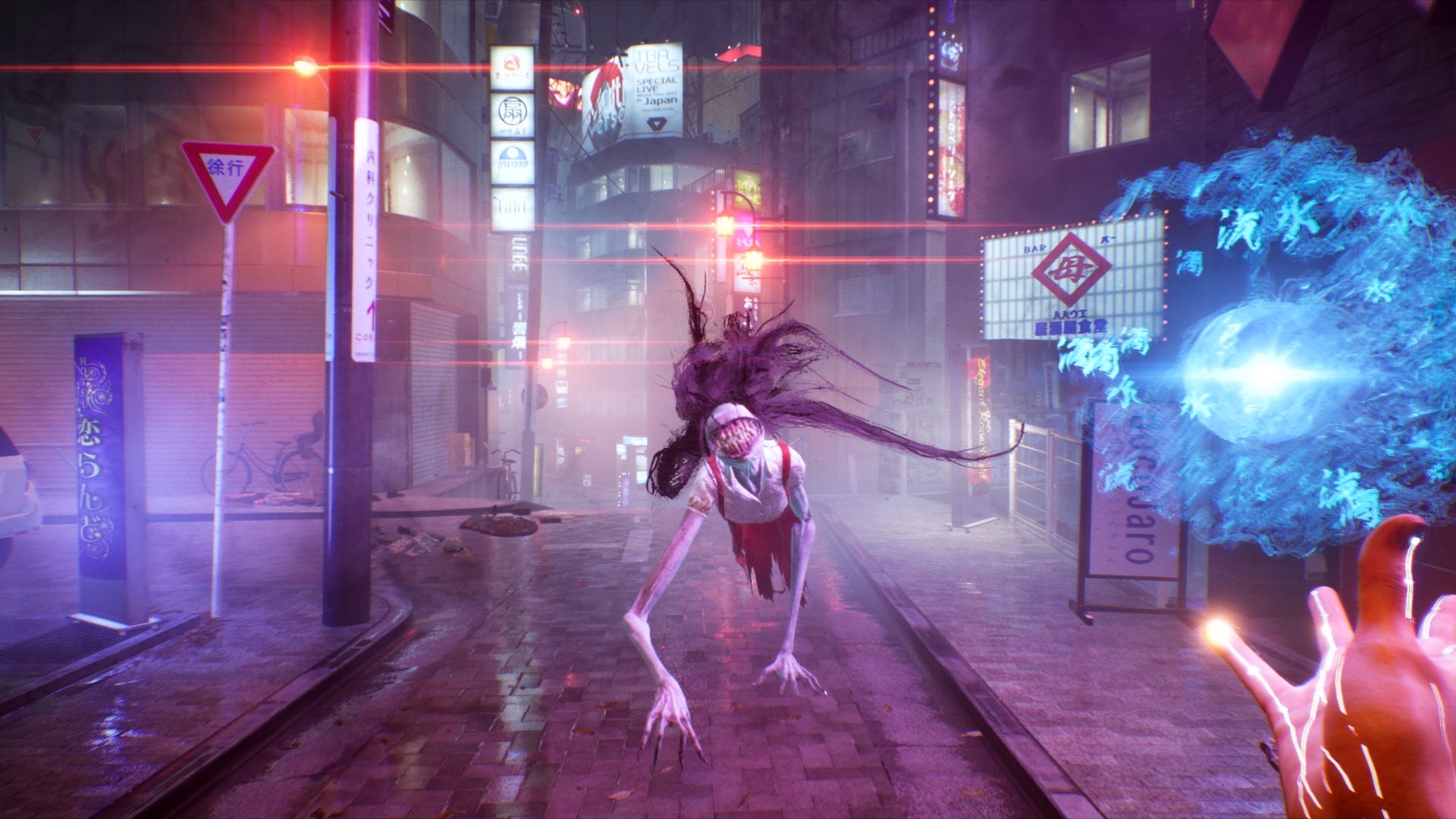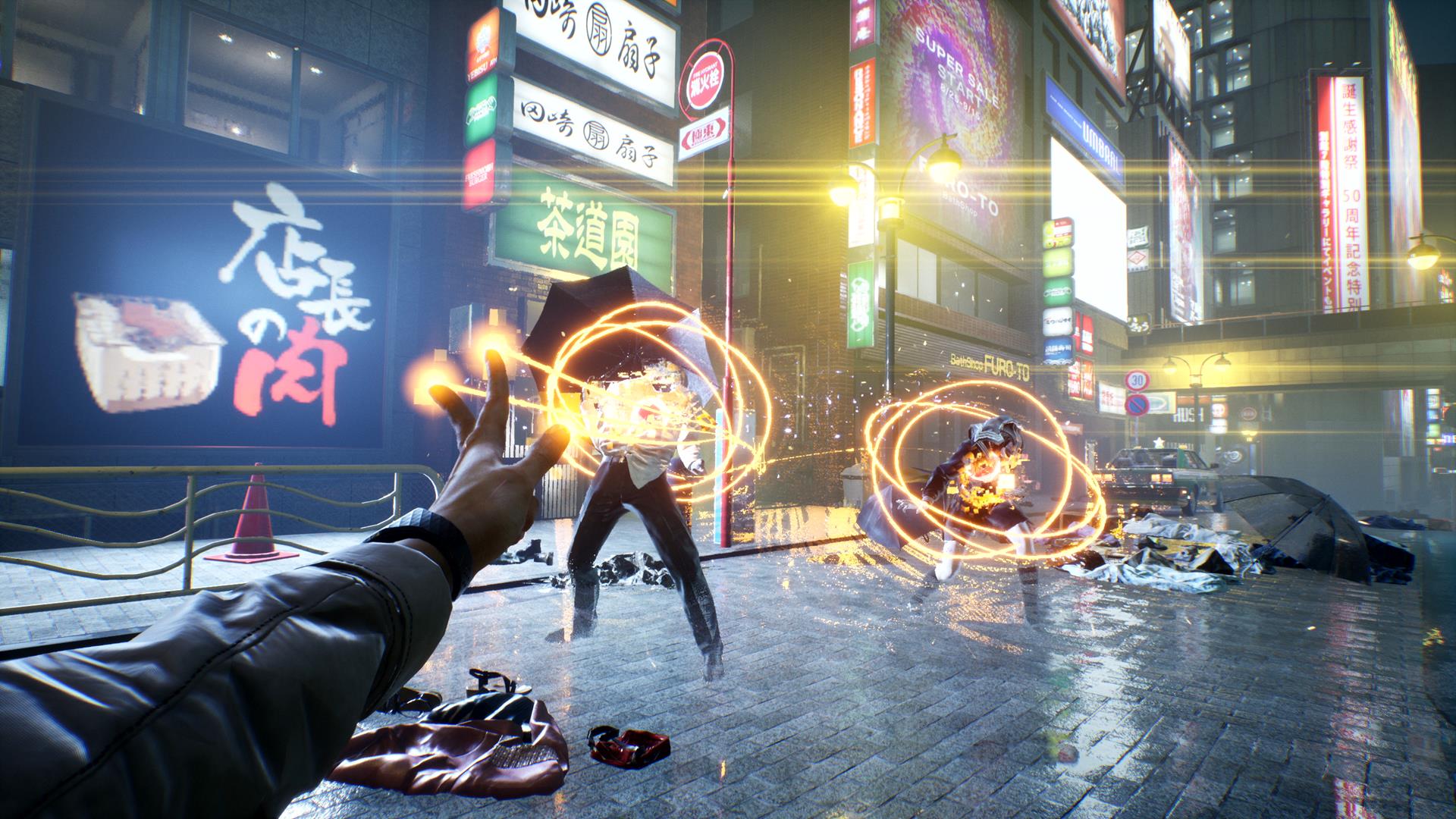Yeah, it’s really weird. Ghostwire: Tokyo’s opening hours put you in the shoes of Akito, a Tokyo-ite who was dead, but has now risen from the grave thanks to being partially possessed by a vengeful spirit called K.K. Co-inhabiting a body, the two set off around Shibuya to uncover why everyone has suddenly disappeared, leaving only their clothes behind, and why a guy in a Hannya mask is pursuing Akito’s sister. Akito’s got control over his body, save his right arm, which K.K. commandeers to blast spiritual energy at demons around Shibuya. An odd buddy cop dynamic blossoms between the duo in a matter of hours, as K.K. constantly talks smack to Akito, and the latter gives as good as he gets, berating K.K. for his dirty apartment and other strange habits. Akito takes the whole “everyone vanishing off the face of the earth” thing remarkably well, and Ghostwire hits the ground running with its overarching narrative of saving the city. The actual act of saving said city usually involves dispelling demons with Jujutsu magic. Akito sends fireballs, water wheels, and gusts of air careening towards Yokai with K.K.’s arm, even employing a sharpshooting bow that can take out enemies from stealth. There are plenty of tools to mess with in Ghostwire – and that’s before the blocking system comes into play. You can dispel rapid enemy attacks by timing your block just perfectly, making for a nice flow in the action if you get your rhythm right. In boss fights especially, with projectiles whizzing towards you, this makes for some brilliantly absorbing and rapid gameplay. If the main story of Ghostwire gets right down to business, it’s the side content where things get zany. Akito’s supernatural abilities extend to reading the thoughts of Tokyo’s animals, for reasons unknown, and at one point he’s beckoned over by a tanuki, who’s written as what can only be described as an Italian American mobster, to find his friends. The tanukis came to Shibuya to take in the sights, as tanukis are want to do, but now they’ve all got split up on account of the demonic invasion business, and it’s your job to track them down and reunite the furry retinue. The whole thing is just so unashamedly weird and wacky, it’s almost commendable. Ghostwire really isn’t worried about juxtaposing two tonally different things – like saving thousands of lives with reading the thoughts of a dog to discover they’re hungry – and the result just works remarkably well. You can be battling a Yokai with scissors the size of your arms, gnashing away at your throat, and turn around to find a tanuki beckoning you over for a new adventure. The story-related hijinx are matched only by Ghostwire’s enemies. Since Shibuya’s been inexplicably abandoned, Yokai called “Visitors” have set up residency all over the ward. In Japanese folklore, Yokai are sort of otherworldly visitors, usually starring in children’s books to pass on messages and morals of how to be a better person. Ghostwire sort of ditches the moral trappings of the Yokai to conjure up demonic entities that play on modern horrors; there are schoolchildren with missing heads, for example, or an imposing thin man with an umbrella who bears an admittedly striking resemblance to that of Slenderman. The Yokai are the perfect vehicle for Tango Gamesworks’ artists to stretch their legs. A demon will look imposing enough carrying gigantic scissors around, but then they’ll pull back the brim of their oversized hat to reveal a sadistic smile burned across their face. A kid in a sleek yellow raincoat will dance about in roads and alleyways, but get too close to them and they’ll unleash a bone-chilling roar, dredging up other Yokai to try and murder you. Both Evil Within games were rooted firmly in western artistic trappings, which isn’t surprising given studio head Shinji Mikami’s history with western-based survival horror games, but Ghostwire represents the chance for the studio to cut loose from what it’s been known for over the past decade or so, and venture out to new artistic territory. Ghostwire is just so superbly stylish. The opening two chapters unfold entirely at night, and it’s a treat to wander around Shibuya’s neon-drenched streets, with a fine rain coating everything in a slick shine. There’s also a surprising amount of verticality at work in Ghostwire, as you can latch onto flying Tengu spirits and zip up to them, and actually glide for a short distance over Shibuya’s towering rooftops. Ghostwire’s Shibuya feels primed for getting lost in over dozens of hours, all which will be filled with eclectic characters, quests, and enemies. If these first few hours are anything to go by, it’s incredibly intriguing to think what the rest of Ghostwire: Tokyo might be hiding in its neon-lit, rain-drenched streets. Ghostwire: Tokyo is out for PS5 and PC on March 25. If you want to learn more about Shinji Mikami and his other projects, you can read about his hopes that any potential Resident Evil 4 Remake improves on the original story that he himself wrote, and his desire to direct at least one more game.

